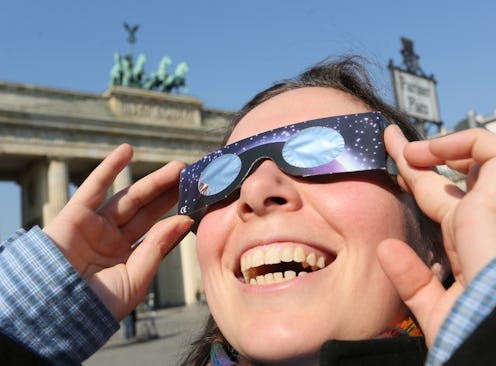
With the Great Eclipse mere days away, many folks are asking some very important questions about solar eclipse safety right now — including, “Do solar eclipses glasses work?” The short answer is yes, they do — but there’s a caveat: You absolutely have to make sure your solar eclipse glasses are legit. If they are, you’ll be fine; but, well... let's just say that this is not the time to try to DIY your own or take chances on a sketchy company. Your eyesight is literally at stake.
The OC Register has a great explainer on both exactly how solar eclipse can damage your eyes, and how solar eclipse glasses prevent this damage from happening. According to the OCR, if you look directly at a solar eclipse without the right protections, there are three different ways it spells bad news for your vision: First, visible light hits; then there are UVB rays, which can burn your corneas’ outer cells (aside from being painful, this can cause blurry vision); and then there are UVA rays, which can affect your retina and macula. If your retina and macula are damaged badly enough, macular degeneration and/or permanent blindness may occur.
Solar eclipse glasses, however, are made from a material that thwarts all of these kinds of harmful rays: Black polymer, which is “a flexible resin infused with carbon particles,” according to the OC Register. It’s a whopping 100,000 times darker than standard sunglasses are (yes, even your high-end, fancy-schmancy ones), and will block out all UV rays, as well as almost all visible light.
According to Pop Sci, legit solar eclipse glasses are certified safe according to the International Organization for Standardization (ISO) standard ISO 12312-2; if your eclipse glasses have achieved this safety standard, they’ll be labeled as such. As NASA explains on their 2017 total eclipse website, “If your eclipse glasses or viewers are compliant with the ISO 12312-2 safety standard, you may look at the uneclipsed or partially eclipsed Sun through them for as long as you wish. Furthermore, if the filters aren't scratched, punctured, or torn, you may reuse them indefinitely.”
I cannot stress this enough: There are no substitutes for real solar eclipse glasses. You can’t use regular sunglasses as solar eclipse glasses. You can’t use 3D movie glasses as solar eclipse glasses. You can’t use glasses labeled as “solar eclipse glasses” without an ISO 12312-2 label as solar eclipse glasses. You can only use solar eclipse glasses as solar eclipse glasses. Anything else will result in damage to your eyesight.
Remember how solar eclipse glasses are 100,000 times darker than sunglasses and block out all UV rays and almost all visible light? That’s no joke. As the OC Register explains, sunglasses, which are typically made of glass, plastic, or polycarbonate material, only block out 10 to 20 percent of daylight and most UV rays; they also still allow visible light to pass through. All of that is bad news for your eyes if you’re looking at an eclipse through them; it’s just not adequate protection.
And 3D movie glasses? They don’t even work the same way that solar eclipse glasses do. As Mental Floss explains, current 3D movie technology is based on linearly polarized stereoscopy:
Two images are projected through polarizers of two different orientations, typically 45 and 135 degrees relative to the horizon. Thep rojected images are then filtered using polarizer films in the lenses of your glasses en route to your eyes. In this way, one image is excluded from your left eye while the other image is excluded from your right.
The polarized lenses in 3D glasses do absolutely nothing to block out the harmful rays of an eclipse; nor do carbonized eclipse lenses have anything in them that will allow you to see 3D images. These two kinds of glasses are simply not interchangeable; they're meant for entirely different purposes.
What’s more, you’ll want to make extra, extra sure your solar eclipse glasses aren’t counterfeit. As PopSci notes, counterfeit eclipse glasses are everywhere right now — and if you ordered yours from anywhere other than a vendor listed on the American Astronomical Society’s list of reputable vendors of solar filters and viewers, there’s a good chance they might be fake. Unfortunately it might be too late to buy another pair from a trustworthy source; according to the AAS, many vendors are already sold out.
You can, however, still view the eclipse with the aid of a pinhole projector. As the American Astronomical Society’s page on pinhole projection notes, “You simply pass sunlight through a small opening (for example, a hole punched in an index card) and project an image of the Sun onto a nearby surface (for example, another card, a wall, or the ground).” This means that when you use pinhole projection to view an eclipse, you aren’t going to be looking through the pinhole directly at the eclipse. (That’s how you burn out your eyes.) Instead, you’ll be viewing the shadow cast by the eclipse as projected through the pinhole on the ground, a wall, or some other surface.
Need a few more tips on how to view a solar eclipse safely? Here you go. As long as you take the right precautions, you’ll be fine. Enjoy it — this is a once-in-a-lifetime event!